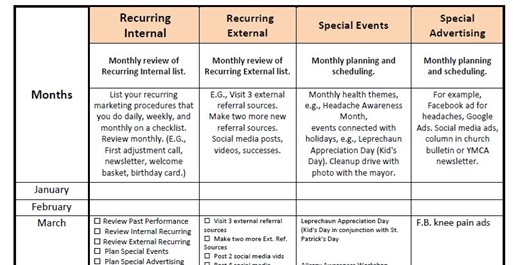Looking to the future


Looking to the future


Patients come second.
As a doctor, you work for your patients.
As a business owner, you work for the business end of the practice.
Both of these roles have different outcomes. As the doctor, your outcome is healthy and very happy patients. As a business owner, you want to see a profit.
When you begin your practice, you do so as a business owner and doctor. Any management or leadership you do is done from these roles. I call this an Entrepreneurial or Personality-Driven Practice. This is workable until you reach about 50% of your full capacity as a provider.
Beyond about 50% capacity, the practice needs focused leadership and management. It is time for you as the owner to step into the role of Clinic Director if you want your enterprise to continue to grow.
The outcome of the Clinic Director is not the same as that of doctor or business owner. In simple terms, the outcome is a well-run organization that provides excellent service at a profit.
So, who does the Clinic Director work for?
The staff! The employees. This is called servant leadership and management.
This is a major shift in mindset for most highly driven entrepreneurial business owners. But it can be done, and if done correctly, there is no limit to practice growth, prosperity, and independence.
Year after year, Southwest Airlines ranks at the top for customer service and profitability over other airlines. And for good reason. They are excellently managed and led!
Their goals, purpose, and values are well-defined. They are a Goal Driven Business.
In their book about Southwest, authors Keven and Jackie Freiberg reveal that Southwest believes that the love and support they show their employees will be passed on to their customers. Servant leadership is a central theme.
Chapter 18 of their book caught my attention: Customers Come Second — But Still Get Great Service. In it, they say at Southwest, “Treat your employees with care and concern if that is the way you want them to treat each other and your customers.”
I use Southwest as an example, but there are many others.
In a smaller service company like a chiropractic or dental business, the doctor doesn’t have much time to be the Clinic Director or senior manager, isn’t paid (at least directly) for being one, and isn’t trained in management. Also, more than likely, doesn’t want to be a manager or leader. But what if there was a simple method to be an effective Clinic Director?
Well, there is. It is covered in my book, the Goal Driven Business, and is gone over in detail in our Practice MBA training program. In 2024, I will post more information on this subject and the Fast Flow CEO Method, as I am 100% certain that this is the stumbling block behind all stumbling blocks that keep practices from achieving greatness.
You can do this now:
If you put your team first, they will put the patient first.
This is, when all is said and done, the Golden Rule.
Or perhaps… we could also call it the Goal Driven Rule!
Seize the Future,
Ed
*Nuts – Southwest Airlines, Keven and Jackie Freiberg
—————————————————-
If your practice building efforts aren’t taking you to your goals,
there are reasons — many of which are hidden from you.
Find out what they are and how to sail to your next level by getting and implementing my new book, The Goal Driven Business.


I asked the office manager if I could review some of the staff’s job checklists.
I had observed a staff member training another on how to use a therapy device on patients. Their attention was on the equipment, how to position the patient and where to place the electrodes.
So, I looked with interest at the job description and checklists about placing patients on therapy. The therapy checklist listed all the procedures – what wire went where, what position the patient was to sit in, etc. But something was missing.
The goal, the outcome, of the checklist was not defined.
There was no mention anywhere about the purpose of the therapy, what it does, why to use it. And worse, there was nothing about the patient as a person. The checklist did not say how to introduce the patient to the procedures – and how to educate them on what it does. It might as well have been instructions on how to hook up jumper cables, wire a sump pump, or fill out tax forms.
I went over this with the practice manager and later was told that the staff were now spending more time with the patients explaining therapy procedures.
There’s a deeper principle here. Steven Covey has a great video on getting his son to take care of the lawn over the summer.
Rather than giving him procedures on what to do, he pointed to the neighbor’s lawn and had him notice that it was green and also clean. He then pointed to their lawn, which was becoming brown and littered. He told his son that all he had to do was keep their lawn Green and Clean. He didn’t care how he did it. He might want to use a hose and sprinkler or use buckets. The specific procedures were up to him. But the goal was –green and clean.
It is an entertaining story on video — the link is below on our blog. The son finally got the idea and worked out how best to take care of the lawn.
Checklists are useful for training, agreeing on who does what, and preventing key procedures from being overlooked. Please use them. We’ve used them for 30 years. (If you need help please contact us!)
But they should always begin with the goal, the outcome of the sum of the procedures. What do these series of procedures produce – and what is their mission?
If you just focus on procedures, you and your team might as well be algorithms, computerized, and repetitive functions that occur electronically. Like an Internet robot or bot! By omitting goals first, you may minimize the innate creativity and power of everyone, including yourself.
On the other hand, if you challenge yourself and your team to define the WHY for each major and even minor procedure:
…and more fun.
Seize the Future
Ed
—————————————————-
If your practice building efforts aren’t taking you to your goals,
there are reasons — many of which are hidden from you.
Find out what they are and how to sail to your next level by getting and implementing my new book, The Goal Driven Business.


Find them, invest in them, and see your practice improve.
One of the aspects of practice development that you become familiar with after 30 or so years in the field is the concept of Leverage Points. Once you can spot them and work out methods to take advantage of them, your practice significantly improves.
According to Donella H. Meadows, Ph.D., leverage points “Are places within a complex system (a corporation, an economy, a living body, a city, an ecosystem) where a small shift in one thing can produce big changes in everything.” *

HIGHER LEVEL LEVERAGE POINTS IN YOUR PRACTICE
Ms. Meadows lists 12 levels of increasing effectiveness where leverage might be found. The top levels that can make the most significant changes are:
This is the Above Down Inside Out shift that can ignite the Innate power in a practice.
I have seen this when the clinic owner or team member becomes extraordinarily inspired and motivated, filled with a sense of mission. I also have noticed this in offices that shift from an entrepreneurial practice that is entirely dependent upon the owner to a systematized and goal-driven business.
TANGIBLE LEVERAGE POINTS
Adding a scribe or clinical assistant can be a practical example of utilizing a leverage point in a more tangible application. This might allow you to see an extra 10 patients a week and provide better service with less stress. In the end, you would have a positive Return on Investment for what you paid for the extra help.
Another example might be a situation where your front desk can’t keep up with check-ins, check-outs, call-ins, questions, data entry, cash collections, marketing reminders, and just being friendly. By adding the right person at the front desk, even a part-time during prime time in the afternoons, your volume might surge. (I have seen this.)
For a marketing example, you might be next door to a gym that sees hundreds of people each month. You could leverage your location with just a little effort to create a very beneficial relationship for their business and yours.
There are many examples of finding areas of your practice where the return will be positive when given more support.
LEVERAGING PRACTICE MANAGEMENT
In my experience, the number one leverage point is management.
As a practice grows, the admin tasks multiply exponentially. These start to fill up the doctor’s time, and eventually, growth hits a plateau.
By adding someone to take care of office administration or clarifying the duties of someone currently in that role, you can better concentrate on service, production, and leadership.
As a result, revenue increases and stress decreases. Proper training for the manager is essential and, unfortunately, usually absent.
As an aside, we are solving this now through our Practice MBA program. We are just a little more than ½ way through the training, and I am both impressed by their work and proud to be helping them become Goal Driven Managers.
But leverage points could be anywhere. Even between your ears! (haha!)
Look for where you might find a log jam or an untapped resource. Invest some time in supporting that area and see if that doesn’t make a big difference in practice.
You have untapped power in your business just waiting to be leveraged.
Ed
*Reference https://donellameadows.org/a-visual-approach-to-leverage-points/
—————————————————-
If your practice building efforts aren’t taking you to your goals,
there are reasons — many of which are hidden from you.
Find out what they are and how to sail to your next level by getting and implementing my new book, The Goal Driven Business.


Remember that time you were leaving for work in the morning and just as you were about to leave, you couldn’t find your keys? (It might have been your wallet, purse, or important papers.) As you tried to quell your rising panic, you thought – what if I am late? What about the patients? What if I have to call a cab, a Lyft or Uber? All the alternative scenarios and plans start weighing on you. Worried, distraught, you get ready to call the office when…there they are! Your keys, papers, the vital components to your daily life and you make a joyous reunion. And you are on your way.
That was a big win.
Five minutes later, you have forgotten the entire dramatic event. As if it never occurred.
Many patients who have had pains or discomforts for years, after finally experiencing relief thanks to your chiropractic care, take it almost for granted after a day or so. Even though it was a big win.
You, too, begin to experience the daily Miracles as Usual as commonplace. You and your team become accustomed to them.
And worse, we can let the “negative few outweigh the positive many.”
Our minds are wired, especially business owners, to be alert for dangers, threats, and failures. And because of this, we overlook the accomplishments, the successes, and the wins we all have.
They happen every day. We get work DONE… when we might have just let it slide. We take the extra time and make the extra effort, even as no one notices. We make it happen.
In an otherwise cold and frightening world, we help others through our actions — and even by our positive presence.
And the world reinforces the negative. Sensation drives all media. It “click baits” us, like emergency flagmen calling our attention to the as-yet-unseen car wrecks ahead of us.
But amidst the world’s chaos, the dramas of our patients, and the struggles of our own lives, we are here to help, and to whatever large or small degree we do, that is a win. We contributed something good into the world that day.
But our wins are easily overlooked. First, by ourselves, and second, by others.
So… don’t let this happen. You can change this! Change it in your practice and change it at home.
And if you do, you will create a more healing atmosphere in your practice and love in your life. Your day will end better, and your next new day will start fresh with greater cheer.
You are doing good work. You are helping people. So are others with whom you work and live.
Recognize and celebrate this, and at the end of each day, simply ask each person with whom you work to tell you and the others their win or wins and cheer for them. Let them do the same for you.
You deserve It – and so do they.
End on a win.
Ed
PS I was reminded of this at the recent Chiropractic Society of Wisconsin conference in Wisconsin. One very successful doctor with whom I had the privilege of talking to mentioned that at the end of the day, he would meet with his team and acknowledge a win each of them had. I too, years ago, had done this with a team I had worked with, but as the world turns, I’ve let this very successful procedure drop aside.
—————————————————-
If your practice building efforts aren’t taking you to your goals,
there are reasons — many of which are hidden from you.
Find out what they are and how to sail to your next level by getting and implementing my new book, The Goal Driven Business.



As farmers know, you must plan ahead and then work your plan. That is part of the Law of the Farm we discussed last week.
This is a short and fast reminder of some activities to consider as we enter into the last two months of the year:
Marketing – The front end of your practice. Keep it hopin’!
Business — The back end of your practice. Organize for the future.
With good scheduling and planning, there is no reason for disappointment in production for November and December. To help keep the atmosphere thankful, cheerful, and productive, here are a few promotional ideas:
Thanksgiving (U.S.A.) Turkey giveaways have been popular with many practices. The basic idea is to refer a friend and enter a drawing for a free turkey.
Thank-a-Veteran Day. Veterans Day – November 11. Special promotions, including free or discounted services or donations to local veterans’ organizations.
Donation Drives. Holiday time always brings an increased demand for helping those less fortunate. Within your office, you can set up a collection area for donation programs in your area.
Girl’s Night Out. This is a shopping/gift exchange that can take place in your office that builds community and helps generate referrals.
Poinsettia Give Away. Give away free poinsettias, one per family. Include cards with a gift certificate for family members or friends for your services.
Your External Referral Network. Deliver a fruit basket or other present personally during December with a card of thanks and mention how you are looking forward to another year working together for better health. Your External Referral Network would include any person or organization that referred a new patient to you, where you gave a lecture or screening, or in any way directly contributed to your office.
Patient Appreciation. Have a party. Your patients are part of your practice and health community. They are a select group of like-minded health seekers. Bring them together, recognize their efforts to improve their health in 2023 and 2024, and encourage them to help others do the same. Everyone gets Guest Passes to hand out to family and friends when they leave. (I still love the Flying Elvis’ coming in for a big patient appreciation party one office used to have!)
Once you get your marketing plan worked out and in gear, take time to review the business situation of your chiropractic or healthcare practice. These behind-the-scenes details are important but not always urgent! They are pretty obvious – this is just a reminder!
Accountant. You will want to meet with your accountant to review your financial statements, including your balance sheet and profit and loss. There have been changes to retirement laws, so check with them about how they may affect you. Review your tax situation and explore strategies to minimize it. Ensure that all tax-related documents and filings are up to date.
Legal and Licensing. Check the status of licenses and permits and renew them as needed. Consult with your attorney to review contracts and legal obligations.
Employee benefits. Consider benefit reviews as well as bonuses.
Payors. You’ll want to review your insurance contracts and dump any that don’t bring a good return.
Fees. Take a look at your fees and make any adjustments that are needed.
Compliance. This can be delegated, but ensure that you at least minimally meet basic HIPAA and OSHA standards. You can check with your local state association for recommendations for these and any other requirements.
Budget Planning. Work out a general budget for next year that incorporates all the findings from your financial review and business goals.
This is not a complete list, of course.
Preparation is working on your business, not just in it, but it is just as essential.
Let’s end the year prosperous and secure for the future.
Ed
—————————————————-
If your practice building efforts aren’t taking you to your goals,
there are reasons — many of which are hidden from you.
Find out what they are and how to sail to your next level by getting and implementing my new book, The Goal Driven Business.



There could be a hidden barrier that jams your growth and holds you back.
MOST OFFICES WANT TO IMPROVE THEIR NEW PATIENT ACQUISITION. That is, attract more new patients.
At least, that is what many chiropractors and other doctors will say.
Oddly enough, that is not always exactly the truth.
Michel Killen, in his book Sell Futures, Not Features, says:
“Do you want more sales? The question should really be “do you really, really, REALLY want more sales?” This might sound insane and even obvious. Of course you want more sales, who doesn’t want more sales? However having taught and coached sales for a lot of people for a long time, this is often an underlying problem that has a tendency to sabotage our sales driving efforts. …I believe that people are creatures of goal pursuit, meaning they take actions which suit their goals. This means that if a business is struggling with sales, it’s usually because deep down a part of them doesn’t want more sales. This is extremely upsetting and even distressing to a lot of people, because of course they want more sales, everyone wants more sales!””
Well, I couldn’t agree more.
CONSCIOUSLY, you probably want more new patients as you know you can see more visits and, of course, you could use the increased revenue.
SUBCONSCIOUSLY, however, there is another story entirely. The devil’s advocate pipes up and says, “with more new patients, you will come home late, miss dinners with your family, your staff will make more errors, and your notes will start to backlog. You won’t have time to exercise, and your Worker’s Comp insurance will increase.”
But because you are a strong-willed entrepreneur and a bit of a rebel, you charge ahead and spend time and money on marketing. But after a while, you notice that your numbers don’t significantly increase.
Why?
There is a bottleneck somewhere in your office, a log jam, a Capacity Constraint.
The Theory of Constraints, originally discussed by Dr. Eliyahu Goldratt in his book, The Goal, has become a management science that implements a business improvement system. Simplified, it is a process that goes after the biggest constraint in any production process. Once that is fixed, management hunts for the next largest bottleneck, which continues as a never-ending process of improvement.
We adapted this, by the way, for practice management, in our Goal Driven System. The primary goal of the Theory of Constraints is profit. However, to achieve this, we need to look organizationally for the primary roadblock.
These constraints can be difficult to recognize sometimes. Partly because they are hidden and partly because of “damn-the-torpedoes” bias on the clinic director’s part.
For example, the front desk coordinator has been with the doctor for a few years and does a good job. The doctor returns from a new seminar, or someone new in the insurance department is hired, and things change. The doctor notices a moment when the front desk assistant is not busy and assigns them extra work. This happens a few times, and soon, the front desk has become a clerical department, filing insurance, ordering supplies, verifying insurance, and doesn’t have time to ensure all the patients are scheduled. When the phone rings, they kinda grimace and hope it’s not another new patient because they have more paperwork to do. Three months later, the doctor notices that the visits are down and spends more money on marketing.
But what is the real problem? The front desk is plugged up! Sure, some extra duties can be delegated to the front desk, but carefully, and ideally done at separate times when patients are not scheduled.
I have been able to increase patient volume and new patients by helping doctors locate the stuck points, the blockages in the office and open the flows. It could be a clinical assistant that is needed, a scribe, or replacing a staff member that really wants to work somewhere else. Maybe the staff needs better training, or intake forms massively simplified, or just a friendlier and less serious clinical director.
Constraints are like being stuck in a traffic jam. They wear your team down. And they affect your motivation and desire for growth.
Physical constraints result in mental constraints.
The real problem in marketing is not always with the marketing. It is often with the management. Being the entrepreneurial doctor you are, you know enough to make marketing work. You can make it work better once you fix the management of your practice and find the constraints and remove them.
Then, watch your volume pick up and your marketing really work.
Seize your future,
Ed
Want help removing all your constraints? Make an appointment for a quick all and I am sure I can help you uncover a probable bottleneck or two and give a you a couple simple solutions that could help.


The Need for Marketing Never Goes Away
Daylight Savings Time starts in two weeks here in the U.S. And across the northern part of our Planet, Spring begins in 4 weeks (March 20th). Guess that would be autumn for you all in the southern hemisphere.
What a great time to plan your spring and summer marketing.
The Need for Marketing Never Goes Away
No matter how full your practice is, the need for marketing never goes away.
Marketing is business and business is marketing.
Putting something valuable in the marketplace that other people want and will pay for – that is marketing. And that is your business.
The type of marketing you do varies depending on the condition and circumstances of your business. If you are just beginning a practice, you must spend a large percentage of your time and budget on marketing, especially direct response marketing. If you have built up your business, the focus of your marketing can be more on retaining your patients, creating alliances, and world-class customer service and outcomes.
Marketing covers a broad spectrum of activities, but all are, or should be, designed to generate new patients and keep the ones you have.
Trends for the future indicate that, in the end, the best and surest marketing will be customer services and outcomes. The communication channels are so packed and manufactured that your messages will get lost unless you have millions to spend. And now we have AI marketing – ads that robots put together.
Therefore, the best marketing will always be personal – relationship based. You and your people — authentic and interested in your patients and the individuals in your community – delivering extraordinary service and outcomes.
Marketing Plan
Practically speaking, it helps to plan your marketing.
Plan your work and then work your plan, right? So, I have attached a sample marketing plan (link below at the end of the blog article) to help you outline what to do. It is a sample and gives structure to managing your marketing. We’ve used one like this for years, and it works. Make your own and customize it to fit your needs.
And stay tuned for a new service we will offer to help you with your marketing.
But for now, Happy Spring, and Plan your Future
Ed
 How to be happier and more prosperous
How to be happier and more prosperous
One of the unique characteristics of Petty, Michel & Associates is that we visit offices and provide on-site coaching based on what we see.
I remember one doctor whom we worked with for several years. When I visited his office, as soon as he saw me, and the minute he was free, he’d say, “Ed, come on over here, let me check you.”
He didn’t ask permission.
He saw many patients in the morning and the afternoon and always took time over lunch for a workout.
He was focused on adjusting anyone in his sight. Patient after a patient. And because he was so focused, he communicated with certainty and authority and earned the trust of his patients.
If you can strip away from your mind all the administrative tasks, worries, and challenges and just focus on seeing patients, you’ll be happier and see more people.
All the “other stuff” slows down doctors, the administrative tasks that seem to multiply exponentially. Your mind can be either dominated by business concerns — or by the joy of giving and serving.
You have the skill and ability to help others, which must be honored and given full reign to be expressed to its total capacity. It shouldn’t be withheld or hoarded.
A well-trained team and a practice manager are vital. They allow you, and the other providers, to practice your art while they care for everything else.
I have talked to many doctors who visit third-world countries and flat-out adjust 100-200 people in a day. No admin interruptions, just individual after individual, courageously providing service and practicing their craft without concern about reimbursement. They have told me that they would get into a “Zone,” or into a flow… and experience an intense kind of present-time consciousness that they don’t experience in their offices.
Dr. Sid Williams, who founded Life Chiropractic University in Georgia, promoted the idea of “Lasting Purpose,” which was defined as “to give, to love, to serve in abundance without expecting anything in return.”
Being generous doesn’t mean giving your services away. Generousness is a mindset of abundance. It is not withholding your gift and craft but practicing your art freely and abundantly.
To do so, train your staff to take care of everything else and delegate the admin tasks to them. We can help with this. But it first starts by committing to a value of service generosity. In our company, Petty, Michel, & Associates, one of our core values is delivering services in “Abbondanza,” Italian for abundance.
In physics, every action has a reaction. This is also expressed in ancient texts: the more you give, the more you receive. You’re persuaded each day to get lost in admin concerns. Don’t. Get “lost in service.” Admin details need to be tended to, but only during non-patient time, and most should be delegated to your team.
Be a Giver and be generous. Educate, care for, and help more people. Take on this attitude, and you’ll have more fun and be more prosperous.
Ed
*Sid Williams quote: https://lifewest.edu/dr-sid-williams-honored-in-life-wests-sid-square/
Tips on Creating a Goal Driven Chiropractic Practice

Helping your employees pursue their professional goals will help them also pursue the clinic’s goals.
How?
Think of yourself. If you are working on learning a new technique professionally, you might feel more energized.
Why? According to Self Determination Theory, each of us has an innate or intrinsic drive to achieve mastery and competence. We want to improve our ability to control the outcomes we produce to better achieve our goals.
I would also add that helping your team members pursue their personal goals will increase their energy to do the same for the clinic’s goals. So again, think of yourself. Looking forward to that hunting trip, that vacation with your kids to Europe, or getting in shape at the gym can give you more optimism, hope, and zest for doing your best at work.
As Vitktor Frankl says:
It is a peculiarity of man that he can only live by looking to the future.
A Goal Driven clinic is systematized and motivated to achieve its goals. It achieves this partly because it takes into account different survival energies: the patients, the practice, and each employee.
At the first of every year, besides setting clinic goals, the clinic director can meet individually with each team member for a goal-setting meeting regarding their career and professional goals. (Download sample Individual Development Plan forms)
Staff members might be interested in different subjects, such as anatomy, human behavior, customer service, or marketing. Perhaps there are certification programs for staff. Meet with your doctors as well: what areas do each want to explore and study?
Work out the goals, then discuss different approaches to achieve these. Then, check back in 6 months on their progress. The practice manager can ensure that this happens.
You can also discuss the personal development goals of each team member. For example, perhaps they wanted to try a new sport, take a unique vacation with their family, or learn a new language.
This holistic approach to leadership and management is part of what we call the Goal Driven System.
Help your people achieve their professional and personal goals, and they be more energized to do the same for the clinic to achieve its goals.

Your patients’ goals are why we are here.
They are why your staff came to work today and why you went to your last licensing seminar.
Your patients’ goals are why you have a practice and are in business.
So, what are your patient’s goals? What do they want?
On the surface, it is usually to relieve discomfort or pain.
So, like you do, after your initial consult, exam, and imaging, you tell them the cause of their pain and present your treatment program. They nod in agreement, and you begin care.
But when the patient sees the staff member to work out their finances and scheduling, they may have a glazed look and not be too sure what you just told them. Something-something about submarines, or joints, or spondy low dices.
The next week you wonder where they are. Your front desk does recalls. You spend money on more marketing to get more new patients.
You may have experienced a version of this in the past.
And at home, the patient may even feel that they got what they wanted or thought that they wanted. Maybe they feel better. But did they really get what they wanted?
There is a quote questionably attributed to Henry Ford: “If I’d asked customers what they wanted, they would have told me, ‘A faster horse!'”
I get the point. But what people wanted, though they did know about a Model-T, was to travel faster with less horse poop.
You know that four adjustments, in most cases, won’t provide the health solution that the patient needs. But your patients don’t know what you know!
Was that why they didn’t come back for another visit, because you didn’t educate them enough? No.
Was it that you did not motivate them enough? No.
An excellent book on sales that I recommend is by Harry Browne, The Secret of Selling Anything. Brown points out that people are already motivated.
You don’t have to motivate your prospective patient when you initially see them. You just need to discover what is already motivating them.
This takes place in your initial consultation and history, which I feel is the most crucial part of the new patient onboarding process.
Brown offers these three steps.
These questions, and others, open the door to understanding what the other person wants. And if they know you understand them and are authentically interested, they will be more inclined to listen to you and trust you.
Now you both can agree on what they want.
This is a simple procedure that is genuine and caring. Not always easy to find these days, so you will stand out from others by using this method.
I would even spend time now and then rehearsing this. Even the pro’s practice.
Brown is not the only person who has offered this procedure as it is so fundamental. But we can never be reminded of the basics enough. He also said:
…the secret of success is:
Find out what people want and help them to get it.
Help your patients achieve their goals in 2023, and they will help you achieve yours.
Seize 2023!
Ed

It is a peculiarity of man that he can only live by looking to the future.
(Viktor Frankl)
Traditionally, the first of any New Year is an excellent time to take stock of the prior year and make plans for the year to come.
Goals
In business, there are two (three, but for now, we will look at two) types of goals for your business:
Setting production goals for where you want to be 12 months from now is the easy part of goal setting. The hard part is working out the organizational support you will need to achieve your production and collections goals. It could be more than you think!
But keep this in mind:
chiropractic and your services are never the primary barriers to practice success.
It is always management. It is the administrative issues connected with organization, including marketing, that gum up the work, gets in the way, slows your business down and holds you back.
Motivation
Part of management is managing your motivation. Yep… motivation needs to be managed. Keeping your spirits high and your drive strong is necessary for an organization to flow.
And this takes us back to your goals.
Visualizing achieving your goals will stimulate your motivation – and your drive. If you can’t see any way to your goals, well, that can be depressing. But if you can… if you can envision accomplishing your future goals, you will be motivated.
Viktor Frankl
I reference Viktor Frankl in my book, The Goal Driven Business.
Speaking of his experience in a concentration camp, “As we said before, any attempt to restore a man’s inner strength in the camp had first to succeed in showing him some future goal…”
He also said, “Even when it is not fully attained, we become better by striving for a higher goal.”
For your goal setting for the New Year, I recommend you start with your higher goals, the 3rd type of goal, which are beyond production and organization. For example, what brings you bliss? What gives you meaning?
Begin with these goals – the higher, wilder, richer ones. Then, look at your production goals, then your organizational goals.
I encourage you to dream just a bit and look at next year as your playground. What higher, richer, and wilder adventures would you like to accomplish?
Have some fun considering these types of goals and all the ways you would like to achieve them. This will add zest and a special spirit to your production and organizational goals.
Help with Your Future
We want to help you with your future. Your work is important, and helping you achieve your goals has been a driving force and a higher goal within our company for over 30 years.
For 2023, we have a few openings for our Private Client status on our Goal Driven Program.
If you are interested in working with us, please reply to this email, and we will schedule a time to talk.
All of us at Petty Michel & Associates want to help you achieve your goals in 2023
Seize the Future! (Carpe Future)
Happy New Year
Ed
Reference. More information on this is covered in sections in The Goal Driven Business, starting at page 19 and page 116.
 Gratitude is not only the greatest of virtues, but the parent of all others.
Gratitude is not only the greatest of virtues, but the parent of all others.
(Cicero, Prolancio, 100 BC)
As many of us in the U.S. prepare for our annual Thanksgiving events, I wanted to offer a short perspective.
Daily events challenge us, and we struggle to deal with them as best as we can. Events in our offices as well as in our communities, country, and the world can be daunting.
So, it helps to pause, more often than we do, and appreciate the advantages we have from those who have come before us. Likewise, to be grateful for the people we know: our family, friends, and those with whom we work. And, of course, our patients. In small ways and large, we all help each other.
But I also want to mention our future and the opportunity it gives us all.
As we move through the Holidays and winter sets in up here in the Northern Hemisphere, the New Year comes at us again too soon. We live in uncertain times, but as business owners and health mavericks, now is not the time to hunker down as if to hibernate and hope that any storms that occur may pass us by.
They won’t. But we can prepare and seize the opportunities that lie ahead.
Forward-minded entrepreneurs always find a few new approaches to making things better while many business owners remain on the sidelines, wary of jumping into the game and fully committing.
The future offers us the opportunity to play and enjoy the thrill of creatively making a difference, however difficult.
So, enjoy the Holidays, and all those close to you, near and far, in the present and respects to those who have passed. Take time to nourish yourself and those around you. There truly is much to be thankful for!
But while doing so, also appreciate the freedom we all have to make a better practice and a better life in the years to come.
Seize the Day and Seize the Future. (Carpe Diem, Carpe Futurum)
With Gratitude for all you do,
Ed, and all of us at Petty Michel
 Working with different offices, we are always reminded of the fundamentals that apply universally. For example…
Working with different offices, we are always reminded of the fundamentals that apply universally. For example…
Once your patient has committed to getting better, it is your job, and everyone else on the team, to help them achieve their goals.
But in the busyness of everyday office interactions, essential steps along the way can become abbreviated or dropped out altogether.
At one office I recently visited, the patient visits and income were diving downward on a monthly trend. And this was occurring even though the new patient volume had been pretty steady.
When I inquired with the front desk staff, they told me that patients were sick, had money problems, were busy, and blah blah blah.
I asked if this was a new phenomenon. Did patients suddenly become poor, was there a new pandemic? What?
Didn’t get any real answers, as they were busy on the phones doing recalls trying to get people back in the office. The doctor wasn’t sure what was happening. To his credit, he loves adjusting and focuses on providing outstanding care – which he does, usually at a high volume.
Long story short, after investigating, I discovered that the doctor had changed up his treatment procedure slightly, and staff positions had changed. As a result, new patient financial consultations had dropped out. The patients had been getting excellent care but had no idea about their payments and were only scheduled for one visit at a time.
This was a pretty big change! A critical procedure just silently disappeared without anyone really noticing. (Sometimes it is hard to see the forest for the trees. Plug: Consulting doesn’t cost. It pays!)
Everyone at the office is a veteran, hard-working, and goal driven. A great team. But this missing procedure was costing them thousands and preventing patients from getting the full benefit of care.
We implemented several solutions that have worked for other offices.
One solution was the New Patient Log and Checklist. I gave them a sample to customize. It is a lined sheet on a clipboard. Each new patient is listed vertically on the left column, followed by other columns stipulating key actions that should occur on each patient. The Log would include such things as:
You could add more columns, but the most vital aspect of this Log is this: it must be assigned to someone. You and the team can review the NP Log during your morning meetings or at weekly team meetings.
One of the lessons here is to always look for what you and your team are doing or not doing before you look to the environment for why your practice may be slipping – or booming!
And help your patients achieve their health goals by ensuring that they complete all the steps necessary along their health journey to achieve their goals.
Stay Goal Driven for a happier future!
Ed

It was in the 80s at a Parker Seminar, which was in Reno that year, that I first heard the term.
In the opening session, Dr. Jimmy Parker talked about PTC. I was attending as a guest with a chiropractor who introduced me to chiropractic. What an introduction!
Dr. Parker explained that PTC stood for Present Time Consciousness. (Parker had quite a few of these abbreviations!) He explained that a doctor could deliver a much better adjustment if their attention on the patient were in the present time, not thinking about past issues or on future concerns.
I have come to learn that this is a vital but easily overlooked skill.
You can tell when someone is 100% paying attention to you, or maybe not quite, or maybe not at all. And this makes all the difference in the patient’s trust in you, how long they stay with you, and whether they refer others to you.
But maintaining PTC can be challenging in a high-volume chiropractic office or any health office. How many thousands of adjustments does it take until all patients start blending into to one?
A doctor who worked with Clarence Gonstead told me about one evening when he was shadowing Dr. Gonstead. It was around 9 p.m., and the reception/waiting room was full. The doctor said to me that he exclaimed to Dr. Gonstead that his waiting room was still filled with patients. He said that Dr. Gonstead turned to him in the hallway before they went in with the next patient and said, emphatically, “No. I only have one patient, and that is the one I am with now.”
That sounds like he was present with each patient, and perhaps that is at least one reason he was so successful as a chiropractor.
I have seen more than a few techniques, or hacks, that help keep doctors, and support staff, in the present with each patient. For example
I suspect that this is a high-level technique. One for the masters. It can’t be canned. Perhaps it is beyond technique. When accomplished, when you are totally present, the patient innately feels that you are there for them and them alone, and this perhaps speeds their recovery.
I would be interested to know how you maintain Present Time Consciousness. You can add your thoughts here on our blog.
Staying engaged in the present for a better future!
Ed
The power for creating a better future is contained in the present moment:
You create a good future by creating a good present. (Eckhart Tolle)

Are you a chiropractic geek?
Are you a health geek?
Here is Merriam Webster: Geek: “…a person with a high level of knowledge or skill in a field…” “an enthusiast or expert especially in a technological field… [The word geek has] seen increasing use with positive connotations, showing membership in a specialized group (film geek, beer geek) rather than social awkwardness.”
I like the word geek because it indicates someone who specializes in a field and is so engaged that they are not especially concerned with keeping up with what is accepted conventionally. In other words, they are a bit of a rebel.
Steve Jobs, for example, was a geek. A core value of Apple was a “power to the people” idea, that anyone could have a personal computer, not just the big corporations.
Wouldn’t Clarence Gonstead have been a geek? It would be difficult to find many chiropractors who were, or are, as engaged in chiropractic as he was or worked as hard.
I remember years ago when talking with a chiropractor over lunch and all he could talk about was the X,Y,Z axis, something about Euclidean geometry, and bilateral symmetrical function. I was trying to keep up! But there he was, in practice for over twenty years, talking excitedly about the last few patients he had seen. He was a chiropractic geek, for sure.
He also had a million-dollar practice with a very strong practice manager.
Great athletes are geeks in their field, studying and training harder than most. Same with musicians or chefs.
But it is easy to get distracted from your game. Collections, bills, staffing, procedures, marketing, insurance, taxes, and everything that goes along with running a business can cut into your productivity and dilute your concentration on your services.
Don’t let it.
Only the offices that give the highest quality services and deliver the best outcomes will survive, let alone thrive. Organize your administration such that it does not dampen your eagerness to engage with each patient, and continue to study and enhance every detail of your clinical skill.
And as a plug, this is why I wrote the Goal Driven Business – to help doctors be doctors, unfettered by administration, and free to express their skills and interests in their profession.
Organize your office so that you can focus on the science, art, and philosophy of your profession. Do so that you can look at chiropractic and its results newly each day, as if you just discovered its powerful potential to help people become healthier. Go deep on every level and rediscover your profession again, for the first time.
Be a geek.
Goal Driven to seize the future,
Ed

I just read about a new study sponsored by a tech company (Invoca.com*) that sought to understand the buying habits of consumers better.
It revealed that as inflation increases, the expectations of customers do as well.
It pointed out that inflation has consumers rethinking their more expensive purchases, including health care. However, almost two-thirds (63%) report that they’re still willing to pay more to get better customer service.
While consumer shopping is based on price, they’re also demanding better experiences. The survey found that more than three-quarters of respondents (76%) said they would stop doing business with a company after just one bad experience.
When respondents ranked the possible reasons why they would stop doing business with a company, a bad phone experience was second only to high prices.
Another interesting fact I noted was that most consumers ranked the phone as their preferred channel when they needed help regarding a purchase. They may go to your website, but the vital moment occurs on the phone. Not texting, emailing, or even visiting the office in person, but the phone call is the preferred method of contacting you.
And the preferred use of the phone in the 2022 survey was up 8% since 2021.
How your patients and potential patients are treated on the phone has an enormous impact on your weekly practice numbers. I would estimate that up to 20% of your volume could fluctuate based upon the great experience or poor experience someone has with your front desk.
The ebullient nature of the staff person you have plays a key role, but so is that staff member’s experience while working in your office. For example, I have seen visits go up when a new happy-to-be-hired front desk staff member takes over the front desk, only to see the numbers dip after they become discouraged a few months later.
The front desk is the most demanding role you have in your office. They need to always be “on,” eager, and interested in phone calls while at the same time checking people in, collecting money, and chatting with patients as they can.
I have spent occasions rehearsing with the front desk on answering the phone. It is simple, but done correctly, it is an art.
Even if your front desk team are pros, positively rehearse with them now and then – tell them even the experts practice daily!
Constant improvement is the road to excellence, and excellent service is needed in our post-Covid world.
And in the end, all this study points to is that common courtesy, genuine interest in and care for each other, being authentic, and kindness are more valuable than ever.
Ed
*https://experience.invoca.com/2022-invoca-buyer-experience-report/p/1

In a Goal Driven Practice, Goal Driven Job Descriptions are short, fast, and to the point.
And they are used!
They help improve the quality and quantity of services and are motivational.
So, how is this different from other job descriptions?
Most job descriptions are usually a hodge-podge and catchall of unrelated tasks. For example, the front desk job description may include getting supplies, taking x rays, calling attorneys, and scheduling patients. Billing may include marketing and equipment repair.
Staff will do the tasks assigned but end up zigzagging from one function to another, losing focus on what they are doing, and often disengaged in their activities.
In typical job descriptions, the goals are not clearly defined, measured, nor are the expectations stated. Further, employees don’t always see or get recognized for the results of the work detailed on their job descriptions.
Yet another failing of most job descriptions is obvious – they just aren’t used.
Let’s look at how to power up job descriptions so that they are Goal Driven.
Many job descriptions contain the duties of several different roles. A role is an assumed identity. For example, in a restaurant, there are the roles of a server, cashier, dishwasher, and chef, or cook. In a small restaurant, one person may take on a number of these roles, and all these roles would be their job description. Hence the idiom: “chief cook and bottle washer.”
But to be effective, each role needs to be separated, well defined, and organized with the other roles.
In a Goal Driven Practice, job descriptions are broken down into different roles and described in job checklists.
The job checklist begins by clarifying the goals. This includes the mission, the outcomes, what is used to measure performance, and the level of performance expected of that role.
For example, for the role of Patient Accounts, the mission might be something like: “To help the patient pay for all of the services they received in such a way that they will continue to receive services.” The outcome might be a zero balance or “no accounts receivable more than 30 days.” The statistics used to measure this role could be the “percent of collections to adjusted services.” And finally, the expectation might be something like: “All patients very happy with the encounters with Patient Accounts and continuing with their services, with a collections percent of at least 95% of adjusted services average.”
We now list the most important procedures to achieve this goal. The CEO of the office defines WHAT the goals should be – that is leadership. But the manager and those working in patient accounts would work out HOW the goals would be achieved.
Encouraging the team member to define the best procedures to achieve their goals empowers them and gives them autonomy and responsibility for their role. According to Self-Determination Theory, real motivation is intrinsic. It comes from one’s desires and needs rather than external rewards or threats. Edward Deci, in his book Why We Do What We Do, says people “strive for personal causation.” (This is more fully covered in my book, The Goal Driven Business)
If the cook understands that their goal is to make tasty meals that the customers enjoy and for which they will pay, they can be more responsible for how best to achieve that goal.
A team member may have five or more roles, each with a job checklist, as part of their job description. As the doctor and owner, you may have 25! (And if so, that could be a big capacity barrier right there!)
Once the goals are clearly defined … and kept in mind, the rest of the checklist can be easily worked out.
Once per month or more, you or the manager can meet with each team member and do what we call a Coaching Review. This is a fast review of employee performance: at what they are excelling and at what they need to improve. In addition, the job checklist can act as an assessment.
But it is all geared around the goals of their roles. You also ask them what could be added or changed to improve both the quantity and the quality of their outcomes. They can make the changes to the job checklist and make sure you have a copy.
None of this takes a long time to do each month.
Management of your office is not just about getting procedures done. It is about constant improvement in the quantity and quality of their goals.
You may have told your patients something like: “If you do not make time for your wellness, you will be forced to make time for your illness.”
The same applies to managing your business. “If you do not take time to improve your procedures and your people to achieve the goals in their roles, you will be forced to make time to rebuild your practice.”
Steven Covey, in his book The 7 Habits of Highly Effective People put it simply and best:
Begin with the end in mind.
Ed

(This is the third in our series on goals.)
The Cathedral, Stone Blocks, and Your Goals
Christopher Wren was one of the greatest English architects. He designed 53 different churches in London before he died in 1723 at the age of 91.*
There is a story about how he walked unrecognized one day among the men who were at work upon the building of St. Paul’s Cathedral — which he had designed. St. Paul’s Cathedral sits on a hill and is one of London’s most famous and recognizable churches.
“What are you doing?” he inquired of one of the workers, and the man replied, “I am cutting a piece of stone and working hard so I can feed my family.”
As he went on, he put the same question to another man, and the man replied, “I am an expert stonemason, and I am building a solid wall.”
He walked a little further, and around the corner, he asked a third man what he was doing. “I am helping Sir Christopher Wren build a beautiful cathedral that will be a place for worship, where people can come to pray, where the poor can come for clothing and food, for the Almighty.”
This is a parable that has some measure of truth, but I have not been able to find any credible verification. But the point of a story such as this is to illustrate an idea or moral.
All three workers had goals. They expressed these to Sir Christopher when asked what they were doing. We can assume that each stone cutter was skilled, worked hard, and did the same work as the others.
One can guess that their goals kept them motivated. But each viewed their goals differently.
The first two workers had immediate tangible objects as goals – a cut stone block and a well-built wall. However, the third stone cutter’s goal was a purpose, a vision of the future he was working to help achieve.
From this, we can look at all goals at two different levels: at a higher level, such as a purpose, and at a tangible level, which is a practical manifestation of the purpose.
In your practice, these two levels of goals might look something like this:
Higher Goal: Our mission is to help as many people as possible in our community become healthier, relieved of discomfort, and better educated so that they continue to improve their health and those around them.
Practical Goal: A person who completed a program of care, whose pain was relieved and is now healthier and incredibly happy with their results and of the service they received and has enrolled in a wellness program.

Practical goals are quantifiable in a set period. For example, how many new patients can we generate, how many visits can we achieve, and how many programs of care can we complete next month?
There must be an equal emphasis on the higher goal, often called a mission, and the tangle goals, often called quotas or objectives.
Too much attention on the mission, and we live in a dreamland and go broke. Too much attention on production quotas, and we eventually feel like we are on an endless assembly line, find no meaning in our work and lose our motivation.
Like the stone cutters, dream about the cathedral but also set a target for how many blocks you will cut and how many walls you will complete next month.
Both echelons of goals should be viewed, reviewed, revived, and recalculated as needed at each team meeting.
Goals are your future – where you want to be. And, where you want your patients and your community to be. So, nourish them both as a mission and as outcomes, and the work to achieve them will come much faster and easier.
Carpe Posterum (Seize the Future),
Ed
*Wikipedia